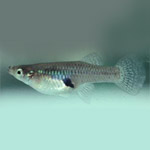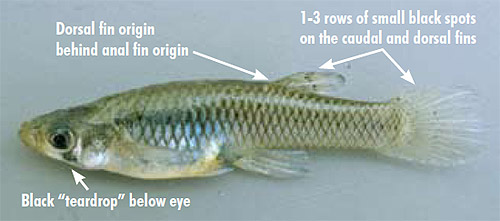Mosquitofish
 Gambusia affinis or Gambusia holbrooki
Gambusia affinis or Gambusia holbrooki
Description
Body: elongate and somewhat compressed; females grow much larger than males and when pregnant show a distended abdomen, total length 22-55 mm (up to 65 mm).
Mouth: small, supraterminal.
Fins: single dorsal fin with 6-7 soft rays, originating behind origin of the anal fin; anal fin of male modified to form the gonopodium, a long rod-like structure.
Scales: 26-32 along the midline (without a lateral line).
Colour: olive-grey to yellow-brown above, yellow and blue iridescence on silver-grey sides; sometimes with a darker midlateral stripe; black spot beneath eye; black anal spot on pregnant female; 1-3 rows of black spots on pale dorsal and anal fins; dark scale outline gives an overall cross hatched appearance.

Photo: [Gambusia affinis, female] John Lyons, Wisconsin Department of Natural Resources
Habitat
Shallow areas in streams, ponds and ditches, with and without vegetation. The mosquitofish can tolerate low levels of dissolved oxygen and high temperatures. It may thrive in degraded and artificial habitats.
Range
In the United States,they are established widely in the west, midwest and northeast, including several states bordering the Great Lakes. Established on all continents except Antarctica.
The eastern Mosquitofish is found in the eastern United States in Atlantic and Gulf of Mexico slope drainages, west through Alabama. The western Mosquitofish is native to watersheds draining into the Gulf of Mexico, from Alabama through Texas, including much of the Mississippi River drainage as far north asIndiana and Illinois.
Pathway of Introduction and Spread
Intentionally introduced in other parts of the world as an agent of Mosquito control; subsequent spread resulted through population growth and dispersal. The aquarium and ornamental pond industries are potential vectors of accidental or unlawful release into open waters, particularly given ongoing public concern about Mosquito-borne disease.
Impacts
As opportunistic predators, mosquitofish readily consume zooplankton and the eggs and larvae of other aquatic vertebrates. This has led to the reduction of populations of amphibians and other fishes, as well as changes to food web structure and water chemistry.
The Invasive Species Specialist Group of the IUCN Species Survival Commission designated the Mosquitofishes as being among the world's worst invasive species.
For more information visit Ontario's Invading Species Awareness Program.
Â
Back to Aquatic Invasive Species List
Â
© Copyright 2004-2025 - CMS Made Simple
This site is powered by CMS Made Simple version 1.4.1


